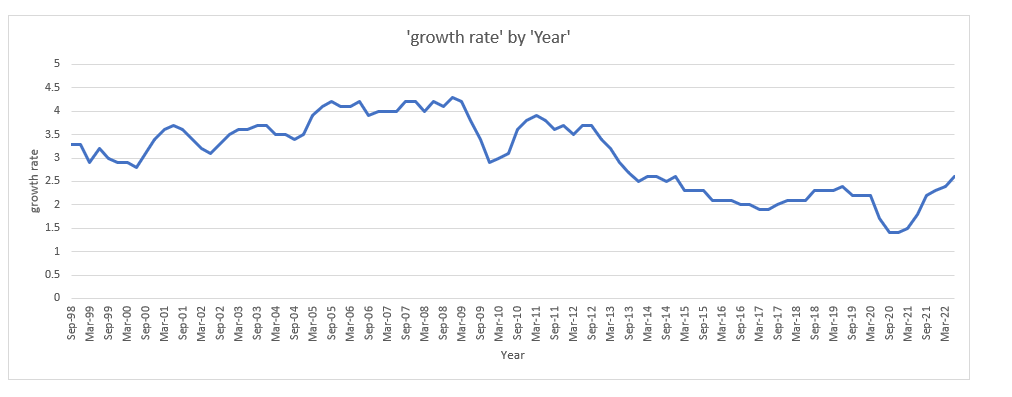What is the average Australian average salary?
With low unemployment rates and increasing job opportunities, Australia’s economy has been expanding steadily over the past few years. The distribution of this growth, though, has not been consistent across all sectors and regions. For instance, other areas might not have experienced the same level of growth as certain cities, like Sydney and Melbourne, which have experienced significant growth in certain industries, like technology and finance.
Based on the average growth rate of 3.05% per year, it is predicted that the average salary in Australia will be around $90,000 per year in 2024.
Overall, Australia has a relatively high average salary compared to other nations, and its cost of living is also relatively high. As a result, a large portion of Australians can live comfortably. With a small percentage of people earning significantly more than the average, income inequality is growing in Australia.
Average Salaries by State
Depending on the state, the average salary in Australia can vary greatly. The cost of living and demand for particular job types are higher in some states, which can result in higher average salaries.
The typical annual wage in New South Wales is close to $80,000. The average salary in this state is the highest of any state. The typical annual wage in Victoria is about $74,000. This state is renowned for its robust economy and employment opportunities in the fields of healthcare, finance, and technology.
The typical annual wage in Queensland is about $72,000. This state’s economy is diverse, with thriving sectors like tourism, agriculture, and mining.
The typical annual wage in Western Australia is around $75,000. The mining industry makes up a significant portion of the state’s economy, which may result in higher average wages for workers in this industry.
Around $70,000 is the typical annual salary in South Australia. The manufacturing and service sectors, which typically have lower average salaries than industries like mining or finance, are what drive the state’s economy.
Around $68,000 is the average yearly wage in Tasmania. The state’s economy is relatively small, and certain job types are not as in demand, which can result in lower average wages.
The typical annual wage in the Australian Capital Territory is around $75,000. The small but highly educated population in this territory works in large numbers in the public sector, which can result in higher average wages.
The typical annual wage in the Northern Territory is around $75,000. This region’s economy is based on mining and agriculture, but there are also lots of jobs in the public sector.
Average Salary by Sector
The average annual wages for various business sectors in Australia are shown in the table below. The data is arranged from the lowest to the highest average annual wage, with the Mining sector having the highest average annual wage at $143,467 and the Accommodation, Cafes and Restaurants sector having the lowest average annual wage of $59,452.
| Business Sector | Average Annual Wage |
| Accommodation, Cafes and Restaurants | $59,452 |
| Retail Trade | $66,092 |
| Other Services | $71,739 |
| Administrative and Support Services | $80,388 |
| Manufacturing | $80,319 |
| Rental, Hiring and Real Estate Services | $82,388 |
| Arts and Recreation Services | $80,958 |
| Wholesale Trade | $83,595 |
| Transport, Postal, Warehousing | $88,199 |
| Construction | $88,186 |
| Health Care and Social Assistance | $93,496 |
| Public Administration and Safety | $96,876 |
| Education and Training | $98,649 |
| Electricity, Gas, Water and Waste Services | $102,507 |
| Professional, Scientific and Technical Services | $103,789 |
| Financial and Insurance Services | $106,730 |
| Information Media and Telecommunications | $108,334 |
| Mining | $143,467 |
Some observations from this table:
- Around $90,000 is the average annual wage across all industries.
- Accommodation, cafes, and restaurants, retail trade, and other services have the lowest average annual wages. These service industries typically have lower pay rates.
- Mining, information media and telecommunications, financial and insurance services, professional, scientific and technical services, and electricity, gas, water, and waste services are the industries with the highest average annual wages. These industries frequently pay more and call for specialised training and knowledge.
- Manufacturing, rental, hiring, and real estate services, arts and recreation services, wholesale trade, transportation, postage, warehousing, construction, health care and social assistance, public administration and safety, and education and training are the industries with average annual wages between $80,000 and $90,000.
Annual Growth Rate
The most recent annual wage growth of 2.6% occurred in the June quarter of 2022 (17/08/2022), according to the Australian Bureau of Statistics.

Some observations from this chart:
- The growth rate remained relatively stable between 3-3.7% from September 1998 to March 2001.
- The growth rate reached its highest point of 4.2% in June 2005 and remained above 4% until June 2006.
- The growth rate then dropped to 3.9% in September 2006 and remained between 3-4% until the end of 2007.
- Following that, the growth rate dropped precipitously to 2.9% in December 2008 and stayed below 3% until March 2010 due to the impact of the global financial crisis.
- From March 2010 to June 2011, the growth rate remained stable at 3–3.9%.
- The growth rate then dropped to 2.5% in December 2013, remained below 3% until March 2015, and reached its lowest point of 1.4% in September 2020, likely due to the impact of the COVID-19 pandemic.
- The growth rate then gradually increased, reaching 2.6% in June 2022.
References
Australian Bureau of Statistics: https://www.abs.gov.au/
